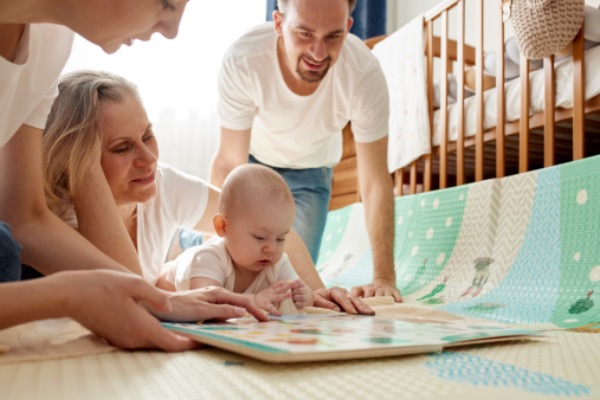Reading with your 3-4 month old might seem more like a one-sided conversation right now, but those tiny ears are soaking in every word you say! At this stage, your baby is just beginning to explore the world around them, and books are a fantastic way to spark their curiosity.
Reading Body Language
By the time your baby reaches three months, they will have developed new ways to express themselves through body language and expressions such as responding with smiles. As you read to your little one, pay close attention to these type signals. Do they start flailing their arms when you flip the page or make a noise when they listen to you?
These responses show that your baby is actively participating in the experience and enjoying the interaction. You can say things like, ‘I see you’re excited!, Let’s make that sound again!’ or ‘Wow, look at those little arms go!” By recognizing and responding to these nonverbal cues, you strengthen your bond, you promote interaction and you also encourage them to continue expressing themselves through their body. Learn how to boost your baby´s nonverbal communication with this activity.
The Foundations of Language
Storytime is a fantastic way to practice early language skills in your baby, and one of the key milestones at this stage is babbling. At this age, your little one isn’t focused on the plot of the story just yet. Instead, they are soaking up the sound of your voice, the rhythm, tone, and the highs and lows that make it so engaging.
Your baby loves hearing you speak, and the more expressive you are, the better! When you exaggerate vowel sounds like “eh” or “ah,” you provide the perfect model for their own babbling practice. These sounds help your little one become familiar with the basics of language!
As you read aloud, try pausing after a line and looking at your baby. Do they respond with a coo or an enthusiastic “ah”? ¡Congratulations! That’s communication in action. To encourage this interaction, repeat back their sounds or expand on them. For example, if your baby coos, you might respond with “Yes, that’s a happy sound!”
Remember, be silly during storytime: babbling is more likely to occur when your baby feels relaxed and happy, so let loose and enjoy these precious moments! To better understand your baby’s development journey, especially the stages of babbling and nonverbal communication, check out this video, where we answer key questions about baby’s communication journey.
Reinventing Storytime
Here are some interactive techniques to build into your reading sessions. Incorporate them to make storytime a fun and varied experience where you practice different skills:
- While not all books are designed to be sung, try it! Babies absolutely love being sung to, and by transforming a story into a musical experience you can help spark their interest in books even more.
- Another fun technique is to cover part of a picture with your hand or temporarily hide the next page. Then, reveal it with a cheerful, “Ta-da! Look at the kitty!” This playful approach keeps their attention but also encourages them to shift their focus between the objects on the page and your hand.
- At this stage, babies are beginning to develop self-awareness and enjoy exploring their surroundings, so another fantastic tool for engaging your baby during storytime is a book that features mirrors. These books allow you to combine reading with self-recognition. As you turn the pages with built-in mirrors, hold the book up for your baby to see their reflection.
Book Recommendations
Here are some of the most popular books for 3- to 4-month-old babies. They offer great opportunities for bonding while promoting sensory exploration and engagement.
- “Who Sees A Bear?” by Eric Carle. It features mirrors on the pages, allowing babies to see their reflections while engaging with the story, and it uses bright colors and simple illustrations that will capture your baby’s attention.
- “Brown Bear, Brown Bear, What Do You See?” by Bill Martin Jr. and Eric Carle. This classic book includes onomatopoeic sounds as it describes various animals and their colors. The repetitive and rhythmic text invites babies to engage and anticipate what comes next!
- “Baby Shark’s Big Show!” by Pinkfong it features music for your baby to enhance with the rhythm and melody.
Happy reading!








